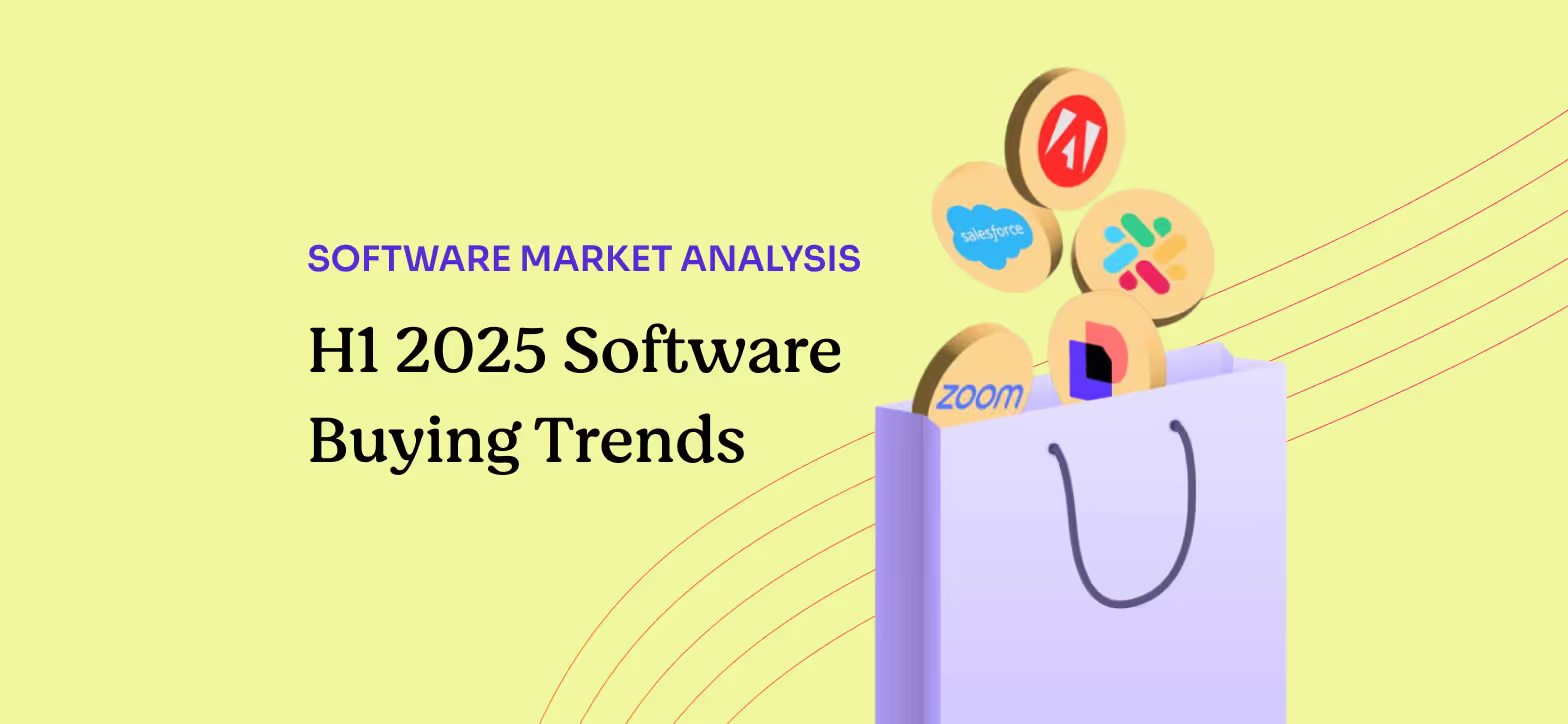Remember pay-as-you-go cell phone plans? That was usage-based pricing in its simplest form. It was a smart way to stay flexible, until a heartfelt three-hour call turned into a $500 bill.
Today’s SaaS contracts aren’t so different. Usage-based models offer real advantages: you scale with demand, avoid overcommitting, and pay in proportion to value. That’s a feature, not a flaw - especially as AI tooling matures and vendors refine how they price around consumption.
But flexibility without foresight? That’s where things get risky when managing software vendors using consumption-based models. You bring these tools in to stay agile and efficient. But if usage outpaces tracking without clear guardrails - or contract terms aren’t built for scale - your budget can drift long before you get a chance to course correct.
Managing usage-based contracts has become a predictably unpredictable exercise in spend variance management.
According to Tropic's internal analysis over $15B+ in spend data, vendors like Twilio, Cloudflare, Datadog, and AWS lead the pack in creating wide swings in actual versus contracted spend. And they're not alone.
While all vendors exhibit some spend variance, here's a full list of top highest-variance culprits we're seeing across the market right now:

Some of these are critical infrastructure, others are growth tools. But they all share one trait: they're built on usage-based pricing models, which means cost is earned in real time. And if you're not watching usage closely, it's too easy to get burned.
Usage-Based Spend: Built for Flexibility, Priced for Variance
The flexible idea behind usage-based contracts makes complete sense. You only pay for what you use. As a CFO, that's music to my ears. These contracts create alignment between vendor value and customer cost.
The inverse is also true though: only paying for what you use can backfire - because what if you use more than you accounted for? Multiply that across a dozen or more vendors, and you’ve got a recipe for budget headaches and volatility.
If usage spikes due to increased product adoption, seasonality, or even a surge in AI prompts and tokens nowadays, your spend spikes too. And unless your finance or procurement team is tightly connected to operational usage, that increase often shows up after the fact as a surprise on the invoice.
As flexible, great, and necessary as they are, usage-based contracts can inject volatility into your forecast, throw off spend models, and strain your cash flow.
The True Cost of Variance is More Than Just a Line Item
Variance doesn’t just mess with the numbers. It undermines trust.
- Your board sees a miss in forecasts and starts asking questions.
- Your cash runway shortens unexpectedly, triggering emergency budget reviews.
- Your functional leaders feel blindsided because they weren’t looped into the spend surge.
This puts extreme pressure on the entire Office of the CFO to contain spend variances and ensure they don’t blow up everything.
Let’s take a moment to quantify the cost:
- A 20% overspend on a $2M annual contract adds up to $400K - enough to cover three senior hires, a full marketing campaign, or 2–3 months of runway for a startup.
- A single auto-scaling cloud environment left unchecked can spike to $15K-$25K in a weekend, especially if tied to a new feature release or bot traffic surge.
- AI credit overruns - particularly with OpenAI’s token-based pricing - can add $50K-$100K in unplanned costs per quarter, depending on usage scale and API integrations.
These are the kinds of gaps that invite scrutiny.
Who Are The Top Vendors Contributing to Unpredictable Spend Variance?
Let’s break down some of the top culprits we're seeing this year:
- Twilio: Messaging and communications spend often scales faster than forecasted due to downstream product usage. You don’t always see it coming (i.e. trial conversions, new customer flows, a spike in SMS volume), and suddenly your bill is outpacing the model. If you’re not tying customer growth to communication triggers, it’s easy to lose the thread.
- Cloudflare: These costs often ramp quietly alongside success—higher site traffic, new edge workloads, analytics spikes. It’s not malicious, it’s momentum. But when spend follows traffic and you’re not tracking by channel or campaign, finance can be left reconciling usage after the fact.
- Datadog: The more you observe, the more you pay. It’s powerful, but without firm policies around data ingestion, retention, or new environment monitoring, cost stacks up fast. One extra log stream can turn into thousands in unplanned expense if it’s not scoped tightly upfront.
- AWS: The godfather of elastic infrastructure - which means cost elasticity cuts both ways. Teams spin up instances, forget to shut them down, or overprovision for performance. Unless you’ve got cost guardrails baked into engineering workflows, you’ll spend more time explaining cloud bills than building margin.
- OpenAI: This one’s the newest and the fastest moving. Welcome to the age of token-based pricing. Prompt experimentation, customer-facing bots, internal agents - it adds up quickly. And because most finance teams haven’t built historicals yet, it’s tough to predict until it’s already on the ledger.
- Zoom, Dropbox, Canva, Adobe, Microsoft, LinkedIn: These aren’t traditionally flagged as “usage-based,” but seat creep and license drift are real. Add a few new hires, spin up a new department, duplicate some shared folders - and your license count doubles before procurement’s even looped in. It’s growth-driven, but without centralized oversight, it becomes spend sprawl.
- Sentry / PagerDuty: Alerting and monitoring tools often spike in moments of failure. Incident noise, test environments left live, and aggressive alert thresholds can lead to cost blowouts. If engineering doesn’t tune these systems, the budget absorbs the chaos.
This isn't to villainize any of these vendors. They're valuable tools…that you just need to keep an eye on.
And to be clear: I’m not suggesting you avoid usage-based pricing. That’s not realistic nor is it wise. The flexibility it provides is critical to avoid overcommitting. But that same flexibility demands stronger financial discipline. It’s on finance and procurement to build proactive guardrails that keep usage spikes from turning into budget surprises.
How to Play Offense: Six Tactics to Tame Spend Variance
When it comes to usage-based contracts, the smartest finance teams are building systems to navigate variance and volatility.
Here’s how:
- Track Variance Live: Use a tool that automatically spots overspending, underspending, and shadow spend in real-time. Waiting for the month-end close is too late.
- Forecast Based on Real Patterns: Use historical data to identify typical usage arcs. Pair that with predictive analytics to generate a more realistic baseline for future consumption. (Pro Tip: Create upper and lower bound models for high-variance vendors. Forecast a 10-30% buffer based on past volatility)
- Build Flexibility into Contracts: Add price caps, volume tiers, and renegotiation clauses. (Example: moving Twilio off pure usage to a tiered model with thresholds)
- Automate Spend Tracking: When usage creeps beyond the baseline, someone should know immediately. Set up notifications when spend nears limits or diverges from normal patterns. Don’t wait for the invoice to see the problem. (Especially helpful for AWS, where 3-day spend spikes often result in 6-month budget damage)
- Bring Procurement and Ops In Early: Some contracts require cross-functional stewardship. If GTM changes are about to trigger usage increases, bring procurement to the table before the spike. The earlier procurement is looped in, the better the contract and operational alignment.
- Schedule Contract Reviews: Don’t wait for renewals to examine performance. Usage-based contracts should be reviewed over regular checkpoints. Build this into your cadence.
Finance’s Job: Build the Muscle to Handle Variance
Think about your biggest cost centers: people and software. For most modern businesses, 70%+ of non-headcount spend touches some form of variable pricing.
This means your FP&A model is only as good as your ability to:
- Normalize volatility
- Plan for upper limits
- Course correct mid-quarter
Here’s a better approach to treat budgeting:
- Scenario planning: Build plans that flex based on usage sensitivity.
- Input-output mapping: Understand what drives cost in tools like Datadog or OpenAI (and who owns those drivers).
- Capital allocation by confidence level: Allocate more precisely when you have better controls. Use buffers where you don’t.
The best teams treat usage-based contracts like strategic bets, not reactive costs. They know which vendors are price elastic and where the spend cliffs are.
Procurement's Job: Move From Gatekeeper to Growth Partner
Procurement isn’t just about cost control, but it’s about cost confidence.
Usage-based pricing requires a higher level of procurement orchestration:
- You need smarter intake processes
- You need data-sharing across finance, IT, and engineering
- You need muscle memory for how to renegotiate early
Too many teams delay procurement involvement until the renewal. By then, your leverage is gone, your budget is off, and you’re on your back foot.
Instead:
- Involve procurement months before during the sourcing stage
- Utilize price benchmarks to see where others are landing
- Understand vendor-specific negotiation levers to get better terms
- Schedule monthly spend reviews with internal stakeholders
Architect Around Usage-Based Vendors and Variance
Usage-based spend variance isn’t going away. If anything, it’s becoming the new normal. From AI tooling to API consumption to hybrid cloud spend, variable pricing is now embedded in the way software and infrastructure are bought.
Remember that flexibility is a great feature, but flexibility without visibility and guardrails is a liability.
This is the new landscape. And the teams who win won’t be the ones who try to cap usage or freeze innovation - they’ll be the ones who build muscle around this spend variance.
Related blogs
Discover why hundreds of companies choose Tropic to gain visibility and control of their spend.







.avif)